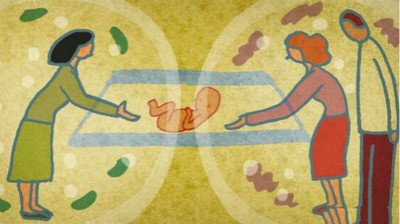Reproductive technology
生育技術
Oh, baby
噢,寶貝!
Britain's approval of babies with three genetic parents offers lessons for other countries
英國通過“三親嬰兒”決議,給他國帶來的影響。
“PLAYING God” is what medicine is for. Every Caesarean section and cancer treatment is an attempt to interfere with the natural course of events for the benefit of the patient. Not every procedure should be allowed, but a general sense of what is “unnatural” is a poor guide to what to ban. Transplants and transfusions were once considered unnatural, but now save many lives. That insight is why MPs were right to agree, on February 3rd, that Britain should become the first country to allow the creation of children with genetic material from three people instead of the usual two.
醫學的初衷本就是“與上帝過招”。曾經剖腹產和癌癥治療被視為是一種對病人有益但卻違背自然法則的手段,可是并非每個步驟都應被人接受,在一般情況下,我們很難對于這類“非自然”的行為頒布禁令,就好比移植和輸血曾一度被定為是一種“非自然”手段,然而這兩種方式卻拯救了無數條生命。正是有這樣的見解,在2月3日,英國國會議員行使表決權,認為英國應該成為首個允許利用“一父兩母”3人基因共同育子(“三親嬰兒”)的國家,從而打破傳統意義上的雙親育兒。
By doing so, they hope to relieve terrible suffering. Faults with mitochondria—the tiny power sources inside cells—afflict about one child in 6,500, or 100 a year in Britain. The many conditions that result, a lot of them agonising and fatal, have no cure. So scientists hope to prevent them at conception, by transferring the healthy nucleus of an egg cell with damaged mitochondria into the body of an egg with functioning ones.
他們希望通過這樣的方式來紓緩一種因線粒體疾病帶來的痛苦。線粒體,作為細胞的動力工廠,卻往往存在一些缺陷。在英國,大約每6500名兒童中就有一個會飽受因線粒體缺陷所帶來的折磨,而這類線粒體相關疾病,每年也約有100例。多數情況下,患者多會感到極為痛苦,因無法治愈,因而多為致命的。因此,科學家們希望能在孕育期間,將捐贈者健康的線粒體與有缺陷的孕方卵子相結合來培育新的生命,以此來阻止或預防這一疾病的發生。

The procedure is not yet allowed anywhere else in the world, partly because it is new and untested in people but also because of the opposition that reproductive medicine often inspires. Mitochondria contain DNA, therefore any child born as a result of such intervention will inherit genes from three people—hence the headlines in Britain this week about “three-parent babies”. If the baby is a girl the genetic tweak in her mitochondria will be inherited by her children, and in turn by her granddaughters' children. It is a “germ-line modification”, and thus irrevocable.
這一方法尚未允許在其他國家和地區隨意使用,不僅是因為這是一項新技術、尚未通過人類測試,更是因為容易激發反生殖醫學派的反對。線粒體本身含有DNA,因此任何一個通過該種方式出生的孩子,都會同時繼承三方的遺傳因子。因此這一周英國的頭條新聞均為“三親嬰兒”。如果誕生的是名女嬰,那么她的基因突變的線粒體將會遺傳給她的孩子,同理的,將會一直遺傳給她孫女的孩子,這是一種“胚芽線式的修飾”,因此該基因無法改變。
This ethical objection to mitochondrial donation is decisively outweighed by the good that ought to come from it. Mitochondrial disease is a misery to those who have it and a terror to those who fear they might pass it on to their children; curtailing it would be wonderful. The complaint that this is the first step on the road to “designer babies” is as weak as any other slippery-slope argument: approving one procedure does not mean automatically approving others.
線粒體捐獻的好處遠遠大于其倫理上的弊端。線粒體病給該病的患者帶來深切痛苦,讓他們害怕會將此病遺傳給其子女,假若我們能通過“一父兩母”這樣的方法,解決這一問題,該有多好啊!有人指出,線粒體捐獻是“設計嬰兒”的第一步,但這種言論如同其它站不住腳的論調一樣不堪一擊,因為允許人為干預這一步驟并不意味著可以自由的發展其他步驟。
A second objection is that this procedure, like any new technique, might not be safe. Those who must bear that risk are not yet born, and so cannot consent to the treatment. But parents already make medical decisions on behalf of their children, even unborn ones. And Britain's bureaucrats, led by the Human Fertilisation and Embryology Authority (HFEA), which regulates fertility treatments, have been scrupulous in assessing risks. The HFEA first granted a research licence for the technique in 2005. Since then, a scientific panel has conducted three reviews of trials in test tubes and in animals. These have given no cause for concern.
第二個反對的聲音則來自于該技術本身。畢竟作為一項新的技術,它并非足夠安全。而這一次要承擔風險的則是那些尚未出生的嬰兒,因而有人反對采用這一治療方式。但換言之,當今父母早就開始代表他們的孩子做出了足夠多的醫療決策,當然包括他們未出世的孩子們。人類受精與胚胎管理局(HFRA)作為英國一家管理不孕不育的機構,一直引導著英國的一些政府機構謹慎的評估該風險。HFRA從2005年起,便首次頒發許可證允許開展這一技術的研究。從那時起,該科學小組就已在試管嬰兒及動物身上進行了三次檢驗,檢查結果也并未顯示存在問題。
From the land of the test-tube baby
源于試管嬰兒
That scrupulousness is one reason why the vote passed as easily as it did. Doctors and patients' groups sometimes criticise the HFEA for being too conservative. But its somewhat ponderous, consensus-seeking approach (the HFEA has conducted consultations, ethics reviews and several opinion polls) has helped Britain steer clear both of American-style culture wars and of the lax oversight found in some Asian countries.
英國在這一問題上始終小心謹慎是該提案得以輕松通過的原因之一,在該問題上有時醫生及患者還指責HFEA在這一研究上過于保守。可是正因為這種略顯遲緩、但又始終保持廣征民意(HFEA多次進行了意見咨詢,道德審查及民意測驗)的態度,使得英國成功避開了美式文化戰和一些法律監管有所疏漏的亞洲國家的反對。
Mitochondrial donation will not be the last piece of controversial medicine that the HFEA will need to wrestle with. It is already possible, for example, to sequence the genes of embryos and discard those that carry incurable genetic diseases. Choosing beneficial characteristics is, for now, illegal. But as the human genome becomes better understood, patients may agitate for exemptions. The HFEA, or something like it, offers the best method for evaluating the benefits and risks of such procedures. Sometimes bureaucrats are just what you need.
線粒體捐獻雖然還飽受爭議,但這仍舊不是HFEA所要面對的最后一件具有爭論性的醫學技術問題。例如,現今的醫學水平已能對胚胎基因進行排序,甚至剔除那些不可治愈的基因性疾病的基因。雖然,目前人為地選擇有益基因是違法的,但是隨著人類對自身基因的不斷研究和深入理解,患者或許會產生對撤銷這一法律規定的訴求,那時HFEA及其類似機構則應為這些醫學技術及步驟進行深入的利弊評估,服務民眾本就是政府機構的職責所在。翻譯:楊靄琳
譯文屬譯生譯世











